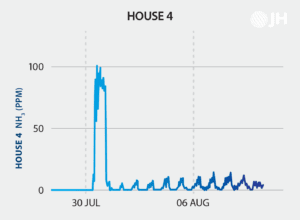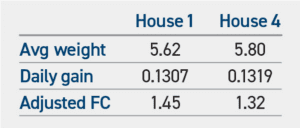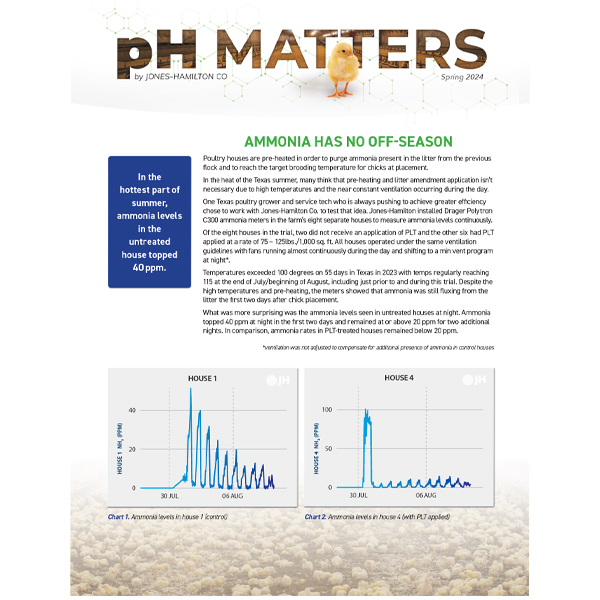Summer Ammonia Trial Yields Big Results
Ammonia Has No Off Season
Poultry houses are pre-heated in order to purge ammonia present in the litter from the previous flock and to reach the target brooding temperature for chicks at placement.
In the heat of the Texas summer, many think that pre-heating and litter amendment application isn’t necessary due to high temperatures and the near constant ventilation occurring during the day. One Texas poultry grower and service tech who is always pushing to achieve greater efficiency chose to work with Jones-Hamilton Co. to test that idea. Jones-Hamilton installed Drager Polytron C300 ammonia meters in the farm’s eight separate houses to measure ammonia levels continuously.
Of the eight houses in the trial, two did not receive an application of PLT and the other six had PLT applied at a rate of 75 – 125lbs./1,000 sq. ft. All houses operated under the same ventilation guidelines with fans running almost continuously during the day and shifting to a min vent program at night*.
Temperatures exceeded 100 degrees on 55 days in Texas in 2023 with temps regularly reaching 115 at the end of July/beginning of August, including just prior to and during this trial. Despite the
high temperatures and pre-heating, the meters showed that ammonia was still fluxing from the litter the first two days after chick placement. What was more surprising was the ammonia levels seen in untreated houses at night. Ammonia topped 40 ppm at night in the first two days and remained at or above 20 ppm for two additional nights. In comparison, ammonia rates in PLT-treated houses remained below 20 ppm.
*ventilation was not adjusted to compensate for additional presence of ammonia in control houses

Chart 1. Ammonia levels in house 1 (control)

Chart 2. Ammonia levels in house 4 (with PLT applied)
It is possible that high ammonia levels at night could be managed with ventilation; however, lower nightly temps open up the flock to the risk of getting chilled, which can negatively impact health and performance. Simply, without an amendment to control the ammonia, you’re introducing potentially negative environmental effects to birds.
Ready to put the power of PLT to work for you this summer?
Impact of High Night Time Ammonia Levels
How much of an impact can this level of summertime ammonia make on flock performance? Turns out quite a bit; so much so that even the grower was surprised.

Table 1. Performance data from control house and PLT-treated house
Previous trials have shown the presence of ammonia during summer, but the addition of the performance data demonstrates the impact something that has previously been thought of as relatively benign can make.
And while there is a cost to any litter treatment, the performance gained from applying PLT at a rate of 100 lbs./1,000 sq. ft. paid for itself four-fold.
There are a number of variables that can impact flock performance, so Jones-Hamilton is working to further validate results by repeating the trial in summer 2024.
Want to receive an alert when this research, and future research, is released? Sign up for a our announcements below.
Sign Up for Alerts

